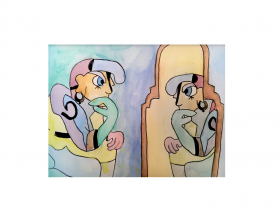Throughout the years, immigrants have managed to assimilate into American society through a variety of forms.
However, assimilating has never been an easy thing: all kinds of immigrants throughout the world have faced all sorts of discrimination. This discrimination has often prevented them from embracing where they come from as the fear instilled in them draws them to lean more towards American ideals and values than their own. This development throughout the years has progressed and is evidently seen today throughout the United States.
When the rise of immigration began in the 20th century, arriving groups of Asian countries like China and Japan received significant backlash because American culture was so reluctant to accept foreigners that strayed from the historical American “image”. This was and is also true of Latino and Hispanic immigrants today. In the mid-1900s after the Bracero Program was ended and several Mexicans found themselves overstaying their welcome, the United States and their efforts to drive them out led Mexicans to become shy about embracing their culture. Despite the backlash and criticism that is still received today, the United States has developed a more accepting reception of all cultural groups than it has in previous years. Putting the politics of administrations aside, the American population as a whole has pushed for more acceptance and inclusion of diversity and culture throughout the United States in schools, job sites, sports teams, religion, etc.
Their efforts are not combatted because they often overpower what the current administration wants to put out.
During World War II, the bombing of Pearl Harbor led to a tremendous shift in the treatment of Japanese immigrants in the United States who had begun to embrace their culture and traditions openly. The internment of Japanese citizens really sent out a message as to how the United States saw and accepted Japanese immigrants. It was a racist executive order that left Japanese citizens feeling very vulnerable and aware of where they came from. After the public apology on behalf of President Ronald Reagan, Japanese-Americans were able to appreciate the apology of error on the government’s end and once more only continued to foster the embracement of their culture.
Similarly, Latinos and Hispanics have received similar criticism especially in recent years with the high rates of migration. They have for years faced a lot of judgment that impacted their ability to feel welcomed. Despite these circumstances, the changes in government and the representation of Latinos throughout the years have contributed to Latinos feel more represented and comfortable in this country.
Altogether, the efforts of the United States have contributed to the practice of immigrants’ culture beyond just the two groups mentioned above.
It is important to recognize that without immigrants, the efforts and development of the United States are almost impossible.
It is difficult for the government to admit that immigrants do positively contribute to society and the economy because to do so would be to accept them, regardless of where they come from– which is an underlying fear they would not want to admit. The U.S. has progressed in the fact that it has dedicated months to different cultural groups to commemorate the history they have accomplished in the United States. There is the celebration of Asian Pacific American Month, Hispanic Heritage Month, Black History Month, etc. While this is definitely a step in the right direction towards accepting the culture of immigrants in the United States, there is still so much that needs to be done.
Today, immigrants have proudly represented where they are from. This is seen in more metropolitan cities like New York City, Los Angeles, Chicago, San Francisco, etc. In these cities, there is an abundance of cultures that can be found through different neighborhoods like Boyle Heights and Little Tokyo in Los Angeles or the Mission District and Little Saigon in San Francisco as well as Chinatown in New York and in Chicago. It is through these neighborhoods that the immigrant culture lives on as there are several museums, street art, restaurants and festivals that encompass the beauty of each culture.
While the political climate today has made it difficult to be more accepting of cultural diversity and the immigrant experience in the United States, the progress that has been made to preserve and commemorate the culture that has existed since the arrival of immigrant groups has been a significant benefit to the United States.
It also shows that despite where immigrants come from, it is so validated to continue the practices of their home countries in terms of beliefs, cultural practices, etc. It can only be hoped that as this country continues to attempt in succeeding an equal acceptance of all cultures that immigrants will continue to be valuable in teaching the United States about where they come from and why it is important that their culture and traditions continue to be practiced.
art by: Mafer Martinez




